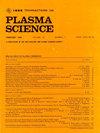Simple Tight Aspect Ratio Machine Assembly to Study ECR-Produced Magnetized Toroidal Plasma
IF 1.3
4区 物理与天体物理
Q3 PHYSICS, FLUIDS & PLASMAS
引用次数: 0
Abstract
This article investigates the influence of toroidal characteristics on vertical charge separation in electron cyclotron resonance (ECR)-produced plasma within a toroidal plasma device featuring a tight aspect ratio and higher toroidicity. Conducting experiments in the simple tight aspect ratio machine assembly (STARMA), the study measures the vertical electric field induced by curvature and gradient drift to comprehend the effect and characteristics of vertical charge separation. Preliminary results from STARMA, distinguished by a high toroidicity and a curvature (研究 ECR 生产的磁化环形等离子体的简单高宽比机器组件
本文研究了环形特征对电子回旋共振(ECR)产生的等离子体中垂直电荷分离的影响,该等离子体是在具有紧凑长宽比和较高环形度的环形等离子体装置中产生的。该研究在简单紧凑长宽比机器组件(STARMA)中进行实验,测量曲率和梯度漂移引起的垂直电场,以了解垂直电荷分离的影响和特征。STARMA 具有高环形度和 9.6 m-1 的曲率($\kappa $),其初步结果表明环形场 (TF) 特性对垂直方向的电荷分离具有显著影响。文章介绍了初步的实验结果,强调了装置内 ECR 产生的等离子体的温度和密度曲线、可能的 O-X 模式转换以及磁场梯度和曲率导致的电荷分离。该装置的独特设计和功能为深入研究等离子体行为提供了一个独特的平台,有助于推动可控等离子体系统的发展,并有可能应用于核聚变研究和材料加工。
本文章由计算机程序翻译,如有差异,请以英文原文为准。
求助全文
约1分钟内获得全文
求助全文
来源期刊

IEEE Transactions on Plasma Science
物理-物理:流体与等离子体
CiteScore
3.00
自引率
20.00%
发文量
538
审稿时长
3.8 months
期刊介绍:
The scope covers all aspects of the theory and application of plasma science. It includes the following areas: magnetohydrodynamics; thermionics and plasma diodes; basic plasma phenomena; gaseous electronics; microwave/plasma interaction; electron, ion, and plasma sources; space plasmas; intense electron and ion beams; laser-plasma interactions; plasma diagnostics; plasma chemistry and processing; solid-state plasmas; plasma heating; plasma for controlled fusion research; high energy density plasmas; industrial/commercial applications of plasma physics; plasma waves and instabilities; and high power microwave and submillimeter wave generation.
 求助内容:
求助内容: 应助结果提醒方式:
应助结果提醒方式:


